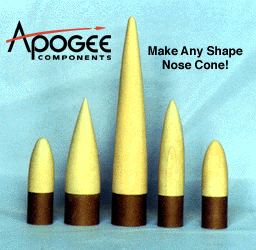Rocket Bodies
The body of a rocket
is not one of the more influential parts. The purpose of the body
is to house the fuel. It is often in the form of a hollow
cylinder because it reduces the amount surface area that is in contact
with the air. This in turn reduces drag. However, the
length of the rocket does affect how the rocket performs. As the
rocket becomes longer, it creates more surface area. This
increase in surface area causes the rocket to have a straighter path in
flight. For this reason, fins are added to the rear of many
rockets to add surface area, and stabilize the rear of the rocket.


This is a picture of a
model rocket with stabilizing fins and nose cone attached.
(http://www.hobbytron.net/model-rockets.html?AID=10117481&PID=1376334)
(http://www.hobbytron.net/model-rockets.html?AID=10117481&PID=1376334)
Nose Cones
The nose cone is on
of the most crucial part of a rocket. The nose cone of a rocket
acts as a way to punch a hole in the atmosphere. Over the course
of time, there have been many designs for the nose cone of
rockets. However, most of them have tried to imitate the
aerodynamics of bullets. The velocity and purpose that the
rocket is going to be use for is often the biggest consideration that
is looked at when choosing a nose cone. At super sonic speeds, a
conical shaped cone is more preferable because it punches through the
atmosphere. But at subsonic speeds, a domed shape is more
preferable because it causes less drag. It causes less drag
because it has less surface area.

These nose cones are just some of the shapes that are available for use in model rockets.
(http://www.apogeerockets.com/make_nose_cones.asp)
Home
Introduction
How a Rocket Engine Works
Practical Application
Bibliography

These nose cones are just some of the shapes that are available for use in model rockets.
(http://www.apogeerockets.com/make_nose_cones.asp)
Home
Introduction
How a Rocket Engine Works
Practical Application
Bibliography